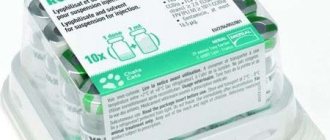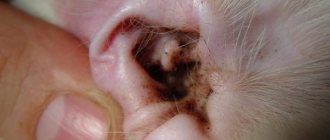Can cats take antibiotics? The answer is yes. There are cases of diseases when you cannot do without them. But before you make any gestures towards antibacterial therapy, you need to clearly know what antibiotics can be given to your cat.
It is not necessary to try to learn their name and purpose; it is enough to make friends with a veterinarian who will always help you choose the right drug, calculate the dosage and comment on possible methods of administration.
The information in the article is for informational purposes only and cannot be used for home self-medication of animals by a non-specialist!
Classification of antibiotics. Release forms
You shouldn’t try to remember all the possible commercial names of drugs that cats can use. It is always enough to ask which antibiotic or active substance is included in the antimicrobial drug.
According to their action, antibiotics are divided into:
- bacteriostatics (inhibit the ability of bacteria to reproduce and develop);
- bactericidal (kill pathogens).
According to the active substance:
- penicillins:
- cephalosporins:
- aminoglycosides:
- fluoroquinolones:
- nitrofurans:
- chloramphenicol:
- lincosamides:
- tetracyclines:
- macrolides:
- sulfonamides:
- glycopeptides:
- polymyxins:
- carbapenems:
According to the spectrum of action:
- wide spectrum;
- highly specific.
By method of administration to the body (how to give an antibiotic to a cat):
- oral (in the mouth);
- injection (in the form of injections);
- local (powders, ointments, gels, etc.).
By origin:
- natural (true) - chemical substances produced by some microorganisms to combat others;
- synthetic – artificially created antimicrobial agents.
The principle of action does not depend on the form of release of the medicine, the only question is the convenience of administration - for some it is convenient to inject, for others it is convenient to give the cat an antibiotic in tablets.
Good to know
- Salmonella spp. in dogs and cats (general information, pathogenicity)
- Acute liver failure in cats and dogs. Rare complications
- Gastrointestinal bleeding in animals (general information, causes, pathogenesis, diagnosis and treatment of sick dogs and cats)
- Hepatic encephalopathy in cats and dogs (etiology and pathogenesis)
- Feline gastroparesis (general characteristics, causes, pathogenesis, diagnosis and treatment)
- Diverticulum and dilation (enlargement of the esophagus in cats and dogs (Megaoesophagus) - etiology, pathogenesis, diagnosis and treatment
- Treatment of liver failure in cats and dogs
- Acute liver dysfunction in cats and dogs: prognosis
- Ollulanus tricuspis of cats, dogs and foxes (etiology, symptoms, diagnosis and treatment)
- Physaloptera rara in dogs (etiology, symptoms, diagnosis, treatment)
- Associated course of panleukopenia and feline leukemia virus (FeLV). Myeloblastopenia
- Campylobacter spp. in dogs (general characteristics, parasitic species)
- Escherichia spp. in dogs and cats - E. coli (distribution, characteristics)
- Spirocerca spp. nematode (Spirocerca lupi) of dogs
- Helicobacter Helicobacter spp. in cats (general characteristics, diagnosis and treatment)
Antibiotics occupy an important place in medical practice. They are prescribed to treat human diseases and to help animals. The drugs are strong in their effects, so only a veterinarian can prescribe them for a pet.
For domestic animals, such as cats, antibiotics are allowed in situations where a previously occurring disease recurs or a new bacterial origin appears. It should be remembered that unauthorized administration of the above medication will have a bad effect on your pet’s health. Before starting treatment, the animal should be shown to a veterinarian for tests to determine the disease.
What is treated with antibiotics
Antibiotics and antimicrobials are indicated for bacterial infections and some types of fungal diseases. This group of drugs does not act on viruses.
In what cases are antibiotics prescribed:
- colds complicated by pneumonia, sore throat or bronchitis, upper respiratory tract infections (rhinitis);
- purulent inflammation of the kidneys (pyelonephritis);
- bacterial inflammation of the urinary system (urethritis, cystitis - also used for catheterization);
- purulent conjunctivitis and otitis;
- pseudomonosis;
- intestinal infections;
- abscesses, deep purulent wound processes;
- leptospirosis;
- chlamydia;
- staphylococcosis;
- bacterial (purulent) inflammation of the skin;
- oncology (to reduce infection of affected tissues by secondary infection);
- elevated body temperature (treatment or prevention of secondary infections in viral diseases);
- postoperative support (for example, antibiotics after sterilization of a cat).
The most popular antibiotics used to treat cats
Are there specialized antibiotics for cats? Yes, there are such drugs, but their production is difficult, so human antibiotics are used to treat pets. Let's figure out which drugs can be given to cats.
One such antibiotic is Azithromycin, which is most often used for middle ear infections, chlamydia, streptococcal and staphylococcal infections.
If your cat has wounds with suppuration, burns, boils or other skin infections, use tetracycline ointment.
Amoxiclav (penicillin group) is used during infections of the digestive system and respiratory tract in cats.
Azithromycin is most often used for middle ear infections, chlamydia, streptococcal and staphylococcal infections
Amoxicillin injection is prescribed to animals for inflammation of the bladder of an infectious nature, inflammatory processes in the lungs, and infectious lesions of the bones.
Gentamicin is the most inexpensive antibacterial agent and is often used for diseases of the bladder, eyes, ear infections, skin diseases, and infectious inflammation of the respiratory tract.
Advantages and disadvantages of antibiotic therapy in cats
The main advantages include:
- reduction of treatment time for the disease, ease of administration, low effective dosages (some antibiotics are used in short courses with a single injection due to their action);
- rapid improvement in the pet’s condition;
- the presence of broad-spectrum properties (when there is no time or opportunity to determine the sensitivity of a microorganism to a particular narrowly acting antibiotic);
- reducing the risk of complications from the underlying disease;
- high efficiency even with a high concentration of bacteria in the body.
The disadvantages of taking antibiotics are:
- with long-term antibiotic therapy, the body's overall resistance to infections decreases;
- long courses can cause microorganisms to become accustomed to the drug and reduce its effectiveness;
- violation of the dosage leads to serious consequences and complications (in particular, if it is exceeded);
- Sometimes it is additionally necessary to take medications that normalize the microflora of the gastrointestinal tract.
It is important to note that all the disadvantages and side effects of antibiotics are minimized with the correct selection of their names and accurate dosage calculations.
Why don't antibiotics help?
Antibiotics do not help an animal if the owner does not follow the veterinarian's recommendations. You cannot prescribe treatment at your own discretion.
The medicine will not work effectively if the instructions for use are not followed. So, for example, if the drug must be administered with food, and it is given to the cat on an empty stomach. If after a certain time your pet does not show any improvement, you should again seek help from a veterinarian. Only a specialist will improve your pet’s health and restore his strength!
Antibiotic drugs are powerful medicines. They fight many infections in humans and animals. After taking this drug, your pet's intestinal flora will weaken. It can be restored with additional medications or on your own.
A nutritious and balanced diet will help the animal’s body regain full health after taking the drug. You can help your cat by stimulating him to take active actions. Walking and playing are very beneficial activities for your pet. Active movements will restore the cat’s body and increase immunity. It is important to carry out the necessary actions in a timely and correct manner and the pet’s health will be good.
Possible side effects from the use of antibacterial agents
Side effects occur in three cases: in case of overdose, incorrect choice of drug (spectrum of action) or individual intolerance to the active substance. It is especially dangerous to give antibiotics uncontrollably to a nursing cat - side effects can appear on the fetuses.
What may be noted:
- vomiting and/or diarrhea after antibiotics (against the background of dysbacteriosis);
- hearing loss;
- convulsions;
- apathy, drowsiness, general depression, inhibited reaction to what is happening around;
- deterioration of coat;
- impaired coordination of movements;
- allergic reactions in the form of itching, rash, difficulty breathing, swelling, anaphylaxis;
- development of secondary infections;
- toxic damage to internal organs: kidneys, liver, brain or bone marrow, etc.
Which antibiotic to choose? Classification by groups
Cat owners must learn the most important rule - only a veterinarian can select antibiotics! Not everyone can inject a cat with antibiotics, because... Not all antibiotics are acceptable for use in cats, not all have analogues in human medicine and can be replaced with some other drug.
If the doctor has no doubt about the diagnosis, then it is best to focus on narrowly acting drugs. If the condition is complicated by secondary infections or there is no time to isolate the pathogen, a broad-spectrum antibiotic certainly comes to the rescue.
Doses of antibiotics are prescribed only by a specialist, based on the specific case of the disease. All information provided is for informational purposes only!
Penicillins
prescribed for purulent wounds, burns and various types of inflammation of dermal origin (bacterial skin pathologies). In some cases, they are prescribed for pathologies of the urinary system.
| Dosage and methods of antibiotic administration | Notes |
| Benzylpenicillin (potassium or sodium), this is (Intramycin, Multipen, Penbex, Pen-Strep) 20-40 thousand units/kg IM or IV every 4-8 hours. The course is determined by a veterinarian. | The main side effect is allergies after the 2-3rd injection (itching, urticaria, rarely anaphylactic shock). In case of an individual reaction to any of the penicillins, it is prohibited to use other drugs in this group. |
| Ampicillin (Albipen LA) 10-20 mg/kg by any route of administration every 6-8 hours. The duration of the course is determined by the type and complexity of the infection. | |
| Amoxiclav (Amoxiclav, Sinulox, Amoxigard, Xiclav) per os twice a day at a rate of 12.5 mg/kg for 5-10 days. | |
| Amoxicillin (Amoxisan, Amoximag, Amoxilong 150, Amuril, Amoxoil Retard, Vetrimoxin LA, Amoxan, Amoxivet) orally at a dose of 10 mg/kg every 8-12 hours, if intramuscularly, then 7 mg/kg once a day or 15 mg/kg once every 48 hours (for long-acting drugs) |
Cephalosporins
broad-spectrum antibiotics, divided into several generations according to their origin and characteristics of action. Suitable for almost any infection, when there is no time to wait for a bacterial sensitivity test or when therapeutic measures need to be applied as soon as possible. Infections of the gastrointestinal tract, genitourinary system, breathing and sometimes vision can be treated. Therapy for sepsis responds well.
| Dosage and methods of antibiotic administration | Notes |
| Ceftriaxone (Ceftrivet) IM, IV once a day, 50 mg/kg or every 12 hours, 20-25 mg/kg. | Very painful with intramuscular injection! Often prescribed after sterilization surgery due to its spectrum of action. |
| Cefazolin 20-35 mg/kg IV or IM 2-4 times a day at regular intervals. | Not prescribed for renal pathologies. Some representatives can be addictive, which leads to the further choice of a stronger antibiotic for treatment. |
| Cephalexin (Mastileks, Cephalen) IM, orally or subcutaneously 10-25 mg/kg once a day. | |
| Ceftazidime (Fortoferin) From 20 to 50 mg/kg every 8-12 hours in a course determined by a specialist. | |
| Cefotaxime (Clafobrine) SC, IV or IM at a dose of 20-40 mg/kg. |
Aminoglycosides
They cope well with colds, the onset of peritonitis, and pneumonia. May help with soft tissue infections. A very toxic group, prescribed in particularly difficult cases.
| Dosage and methods of antibiotic administration | Notes |
| Kanamycin IM or SC 2-3 times a day for a week at a dose of 0.1 ml/kg (25 mg/kg). | Rarely, allergic reactions may occur. If the dosage and duration of administration are observed, there are no side effects. In case of overdose, the kidneys and vestibular apparatus are affected. |
| Amikacin s/c, i/m, sometimes intravenously 5-10 mg/kg 2 times/day. at regular intervals or every 8 or 24 hours. | It is not allowed in case of urolithiasis and severe kidney pathologies. |
| Gentamicin (Gentam, Gentaprim, Gentavet) Twice a day and no longer than 5 days at a daily dose of 2-5-8 mg/kg IM. It is possible intravenously, but very, very slowly along with a drip. | Not for severely weakened individuals, old people or those with kidney pathologies. If used incorrectly, it can cause hearing damage. |
| Streptomycin (Streptovik) IM 10-50 mg/kg twice or thrice a day at equal intervals. The course of treatment is 4-7 days. | In cats it is used for active leptospirosis and carrier status. |
| Neomycin per os 10-20 mg/kg daily or 2.6 mg/ml diluted with drinking water. | Least toxic of all aminoglycosides. |
Fluoroquinolones
completely synthetic antimicrobial substances that have a broad spectrum of action on most bacteria. They are used most often for genitourinary infections, because do not burden diseased kidneys. Some of them can help with bacterial skin pathologies.
| Dosage and methods of antibiotic administration | Notes |
| Ciprofloxacin (Tsiprovet, Tsipromag) Orally 5-15 mg/kg twice a day for 5-14 days | The only adverse reactions are individual intolerance. |
| Levofloxacin (Lexoflon, Lexoflon OR, Ornitil, Endoleks) Per os once a day 10 mg/kg or twice a day 5 mg/kg. Course 5-10 days. | |
| Enrofloxacin (Baytril, Enroflox, Coliflox, Ribaflox, Enroxil, Enromag, Enronit, Enroflon, Renrovet, Kolmik E) Once a day per os or subcutaneously at a dosage of 5 mg/kg for a course of 3-5 days. Can be divided into double doses every 12 hours, 2.5 mg/kg. You can use the drinking version (oral enrofloxacin) in the same dosage, after mixing it with water or milk. | Not for young animals with unformed cartilage tissue. It is forbidden to overdose - it provokes eye pathologies (retinal degeneration). Cats are administered only subcutaneously! The solution has a very bitter taste, which causes severe salivation. |
Nitrofurans
cope well with skin infections, bedsores and skin ulcers, corneal injuries, gastrointestinal pathologies, mastitis. Along with fluoroquinolones, urinary tract infections are well treated. Some representatives of the group are actively used for intestinal bacterial infections (salmonellosis, colibacillosis, enteritis, enterocolitis, etc.).
| Dosage and methods of antibiotic administration | Notes |
| Furagin 5-10 mg/kg every 8 hours for at least 5 days, maximum prescribed by a veterinarian. | Do not use in case of renal failure, pregnancy, or if you have ever had a reaction to nitrofurans. Your cat's urine may become darker in color. |
| Nitrofurantoin The daily dose is 5-10 mg/kg, given in 2-4 doses per day. The course of application is no more than 7 days. It works well for purulent cystitis. | Cannot be used if there is a general intolerance to nitrofurans, as well as in animals with pathologies of the kidneys, heart and liver. With prolonged and uncontrolled use, the composition of the blood changes, nausea, vomiting and persistent diarrhea appear. |
| Nifuroxazide (Nifurovet) Per os 100 mg/animal for 1 dose in capsules or as a suspension. Kittens are given 20 mg per dose. Frequency: 2-3 times a day for 2-7 days (on average, stop giving the drug if there has been no diarrhea in the last 12 hours). Give your cat plenty of water to drink. | Most often used for intestinal infections. Can be used on pregnant cats. It has no side effects with the correct dose and course. |
| Furazolidone Per os at the rate of 4 mg/kg every 12 hours for no longer than 7-10 days. | The color of urine changes from dark yellow to brown. There are frequent cases of toxic liver damage and severe allergic reactions with overdose and use for longer than possible. |
Levomycetins
have a wide spectrum of antimicrobial action and can affect intracellular parasites. Penetrates well into the liver, kidneys, spleen and lungs. An excellent choice for intestinal infections. It should not be used for a long time; there is a high risk of causing dysbacteriosis.
| Dosage and methods of antibiotic administration | Notes |
| chloramphenicol (synthetic) chloramphenicol (natural analogue) (Levanzam, Levotetrasulfin, Lenovit, Fenicol, Chronitsin, Floricol) 10-20 mg/kg per os 2-3 times a day for a course of 3-7 days, depending on the disease. The solution is dripped locally into the eyes, 1-2 drops in each eye. The frequency depends on the concentration of the drug. | Very bitter! After giving it inside, there is strong salivation. In cats, side effects are most common, so it is prescribed quite rarely. |
Lincosamides
any infections of the skin, abdominal cavity, genitals, as well as pathologies of the respiratory tract.
| Dosage and methods of antibiotic administration | Notes |
| Lincomycin (Linkovik) Orally every 8 hours, 15 mg/kg or 22 mg/kg every 12 hours. Slowly IV, 11-22 mg/kg every 12 or 24 hours. IM twice a day, 11 mg/kg or once 22 mg/kg. | Works well for lung and bone infections. Incompatible with chloramphenicol. There are no side effects. |
| Clindamycin (Clindaspectin) SC or per os 10–15 mg/kg, every 12 hours. | Do not use in cats with liver and kidney pathologies. Do not combine with chloramphenicol, erythromycin and aminophylline. |
Tetracyclines
catarrhal and purulent conjunctivitis (especially chlamydia), endometritis, the initial stages of development of peritonitis, pneumonia, pleurisy, sometimes with infections of the genitourinary system. They work well in combination with penicillins.
| Dosage and methods of antibiotic administration | Notes |
| Doxycycline (Doxilox, Doximag, Ronaxan, Paudox, Doxatib) It is best to take 10 mg/kg orally once a day with food or 5 mg/kg twice with an interval of 12 hours. Duration of treatment is 8-10 days. | Only reactions of individual sensitivity are possible. It is better not to give doxycycline monohydrate orally as it causes side effects in cats such as nausea, vomiting, and decreased appetite. Ronaxan, doxatib and paudox (containing doxycycline in the form of hyclate) are best tolerated internally. All other drugs are best used by injection. |
| Tetracycline (Lautsetin) Usually 10-20 mg/kg orally 3 times a day for 7-14 days. Sometimes longer therapy is required. 1-2 drops are dripped into the eyes for up to 3 weeks, if positive dynamics are noted. If not, the drug is discontinued. | Most often used for eye pathologies and chlamydia. Used as a test for viral conjunctivitis - if it does not work, then a virus is involved. |
Macrolides
one of the relatively safe groups of antibiotics. Most often used to suppress secondary infections of the respiratory tract and gastrointestinal tract. They have no effect at all on salmonella, fungi and viruses, and are most active against penicillin-resistant bacteria. In some cases, they may be prescribed to pregnant cats, because... do not pose a danger to the fruit.
| Dosage and methods of antibiotic administration | Notes |
| Erythromycin (Lautsetin, Eridin) Orally 5-15 mg/kg every 12 or 8 hours. Duration is usually no more than 7 days (minimum 5). | Long-term uncontrolled use may cause problems with the liver. |
| Azithromycin (Azitronit, Zitrocox, Azikan) On the first day, take 5-10 mg/kg orally once, from the third day the interval between doses can be increased to 48 hours. The course is calculated by the veterinarian. | Do not use with heparin. The only side effects are flatulence. Works well for respiratory tract infections. |
| Tylosin (Makrolan, Tilovet, Tilomag, Farmazin, Frazidin, Tilar) 2-10 mg/kg IM once a day or 7-11 mg/kg orally every 6-8 hours. The course is usually 3-5 days. | It tastes very bitter and injections are sometimes painful. On days 5-6, painful bumps may appear at the injection site. |
Sulfonamides
bacteriostatics that are well suited for infections of the respiratory tract, genitourinary system, gastrointestinal tract, enteritis and some viral infections as suppressors of secondary infections. If necessary, they are prescribed in combination with bactericidal antibiotics for pyometra (purulent inflammation of the genital organs).
| Dosage and methods of antibiotic administration | Notes |
| Streptocide 0.3-2 g orally every 4-5 hours, starting with large doses. The duration can be up to 14 days. | In addition to internal infections, streptocide can be sprinkled on wounds. Internally to treat a sore throat, you can mix it with butter. |
| Biseptol Orally 40 mg/kg twice a day for 10-14 days. | Under certain conditions, you can inject a cat with fungal pneumonia. Bitter, it is better to give in the form of a suspension. Do not give if there are liver pathologies. |
| Phthalazole 0.1-0.2 g/kg for oral administration 1-3 times a day for 10 days. | Not given for pathologies of the kidneys and liver. Good for small kittens. |
Glycopeptides
a very strong group of natural antibiotics, rarely used to treat cats, because belongs to the reserve group. They are excreted unchanged by the kidneys, so they are not prescribed for pathologies. Mainly useful for the treatment of meningitis, infective endocarditis, severe sepsis, when the infections are severe and cannot be treated with other antimicrobial drugs.
| Dosage and methods of antibiotic administration | Notes |
| Vancomycin IV only - 12-15 mg/kg every 8 hours. The duration of administration is determined only by a veterinarian, depending on the complexity of the situation. | It is strictly forbidden for pregnant cats to take it if they need to get a healthy litter, and if they have chronic kidney pathology. May provoke hearing and kidney damage, tachycardia, thrombocytopenia. |
Carbapenems
a very strong group of antibiotics, administered only by injection (parenterally) and for special protracted and multi-resistant infections, when conventional antibacterial agents do not cope.
| Dosage and methods of antibiotic administration | Notes |
| Imipenem 3-10 mg/kg with IV or IM administration. The duration of the course is determined by the veterinarian. | May change some blood parameters, allergic reactions and anaphylaxis are possible. |
| Meropenem 5-10 mg/kg by any injection methods. In special cases, the dosage can be increased to 24 mg/kg once a day when administered intravenously. |
Antifungal antibiotics
a narrow group of agents that act on various types of fungi, including ringworm.
| Dosage and methods of antibiotic administration | Notes |
| Griseofulvin (Dermicocide) Very long-term (3-5 weeks) orally 10-30 mg/kg twice a day every 12 hours. | There may be diarrhea and urticaria due to individual sensitivity or overdose. Do not use with liver and heart problems. |
| Nystatin Orally from 20 to 750 thousand units/cat 2-4 times a day for 10 days, depending on the severity of the condition. | Copes perfectly with candidiasis of various localizations. Low toxic. |
| Levorin Orally from 20 to 750 thousand units/cat 2-4 times a day for 10 days, depending on the severity of the condition. | Cannot be used for liver pathologies. |
Nitroimidazole
antimicrobial and antiprotozoal group of broad-spectrum substances. It is prescribed when the diagnosis is beyond doubt, and the benefits will definitely be higher than the harm from side effects.
| Dosage and methods of antibiotic administration | Notes |
| Metronidazole (Metronide, Stomorgyl, Trichovet, Ursometronide) Orally 10-20 mg/kg 1-2 times a day. When administered intravenously (with a concentration of 5 mg/ml), the consumption is 2-5 ml/kg of body weight, depending on the type of infection. The frequency is also 1-2 times a day. | Positively affects the overall immunity of the body. Allergic reactions and side effects on the kidneys are common. The maximum permissible high doses are taken for protozoal infections. |
Of course, this is not a complete list of those antibiotics that generally exist in groups and that are approved for cats, but only the most frequently encountered and used in veterinary practice. In total, about 25 types of antibiotics are used in veterinary medicine, but not all are acceptable for use in small animals.
Kinds
The appropriate antibiotic is the one prescribed by a real veterinarian. It is he who can correctly diagnose and select an effective treatment. You should not take on these functions yourself. There are almost two thousand types of antibiotics, only 25 of them are used by veterinarians in their practice. It’s very easy to make a mistake and even cause harm.
Penicillin or ampicillin is used for burns, ulcers, cuts, and treatment of stale, festering wounds. It shows good results in the treatment of pleurisy, peritonitis, urinary tract infections, and respiratory system.
Streptomycin is used more often as an adjuvant to penicillin, but not only, it also serves as the main medicine. Effective for endometritis, conjunctivitis, promotes rapid healing of wounds and recovery from infections of the genitourinary system.
Tetracycline ointment is indispensable for conjunctivitis, skin diseases, helps with inflammation of the gastrointestinal tract and respiratory system. You can use tetracycline in tablets or injections.
Cephalosporin is prescribed for enteritis, sepsis, infectious diseases in the respiratory and genitourinary systems, skin inflammations, and purulent accumulations in the uterus.
Gentamicin eliminates eye infections, diseases of the gastrointestinal tract, nasal pharynx, and reproductive system. Its use requires a preliminary kidney check. You may have to replace it with an analogue one.
Enroxil will help eliminate skin diseases and cystitis, especially since animals tolerate it well.
General tips for use
Self-medication is highly undesirable!
You should not prescribe antibiotics for cats yourself, especially if it is a purely human drug. All appointments are made only by a specialist and ideally after testing potential bacteria for sensitivity to a particular drug. In this case, the therapeutic effect will be most noticeable. If this is not possible, only a veterinarian should select a general antibiotic.
An antibiotic can be harmful if given inappropriately or in the wrong dosage
Antimicrobial drugs should be prescribed only in cases where it is obvious that they cannot be avoided. Compliance with dosages is important. Otherwise, taking antibiotics is a recipe for complications and super-infections, when microorganisms develop resistance and mutate, becoming stronger and causing infections that are difficult to treat.
Taking probiotics
It is rare, but it happens that after antibiotics a cat begins to suffer from indigestion due to dysbacteriosis, because the drug “kills” and is more beneficial for intestinal bacteria. Therefore, immediately after a course of antibiotic therapy, you should start taking probiotics - drugs with a concentration of beneficial intestinal microorganisms. This should not be done simultaneously with antimicrobial drugs, because they will continue to die from the drug.
A course of treatment
Each antibiotic comes with instructions that clearly state how many days the treatment should last. Under no circumstances should you shorten the treatment time with antibacterial agents on your own! Usually the course lasts at least 5 days, then, if necessary, it can be extended to 7, 10 and 14 days (unless otherwise indicated in the instructions).
There are long-acting antibiotics, when a course of a maximum of 3 days or even 1 injection/tablet for 5-7 days is sufficient. All these nuances are spelled out in the instructions.
If you shorten the duration of use, you can thus worsen the cat’s health and develop microorganisms’ addiction to the drug, which will be the reason to choose more complex and strong antibiotics for treatment in the future.
Antibiotics affect the reproductive system
The negative impact on the ability to reproduce can be reduced by taking a break between matings and the end of the course of antibiotic therapy. Typically, for at least 3-5 months, depending on the drug used, the cat cannot be mated to produce offspring. There are high risks of miscarriage or the appearance of an offspring with congenital anomalies. Some antibiotics, through their toxic effects, can have a negative effect on the primary formation of internal organs after fertilization and development of embryos.
Fungal diseases cannot be treated with antibiotics
Not everyone knows that some antibiotics are a breeding ground for stronger growth of fungi. The pet's condition will only worsen. To treat cats in this case, specialized antifungal agents or special antifungal antibiotics are used. In other cases, antibacterial agents are not used.
Strictly prohibited combinations of antibiotics
Not all antibiotics can be used at the same time. There are combinations that are strictly prohibited and can have serious consequences for your pet’s health!
Do not mix:
- Aminoglycosides and cephalosporins (the nephrotoxic effect increases, acute renal failure or nephritis develops).
- Nitrofurans and fluoroquinolones (full antagonists that cancel each other’s effects).
- Fluoroquinolones and cephalosporins (severe kidney damage (nephrotoxic effect), leukopenia).
- Sulfonamides and chloramphenicol (pharmacologically incompatible).
- Aminoglycosides, vancomycin, polymyxin with furosemide (a sharp increase in the toxic effect on the hearing organs until it is completely lost).
- Beta-lactam antibiotics and carbapenem (obvious antagonists).
- Cephalosporins (especially ceftriaxone) with calcium gluconate (especially in one syringe).
- Aminoglycosides (in particular gentamicin) and penicillin antibiotics cannot be mixed in the same syringe (antagonists, increasing the ototoxic properties of gentamicin). At the same time, combination therapy with different injections is welcome.
- Ceftriaxone and vikasol (complete neutralization of the effect of vikasol).
- Polymyxin, penicillin and cephalosporins (pharmacological incompatibility with each other).
Author:
Grinchuk Ekaterina Andreevna veterinarian











